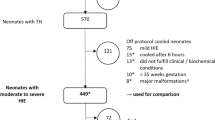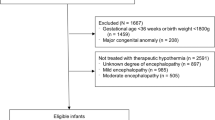Abstract
Objective:
To evaluate cooling practices and neonatal outcomes in the state of California during 2010 using the California Perinatal Quality Care Collaborative and California Perinatal Transport System databases.
Study Design:
Database analysis to determine the perinatal and neonatal demographics and outcomes of neonates cooled in transport or after admission to a cooling center.
Result:
Of the 223 infants receiving therapeutic hypothermia for hypoxic ischemic encephalopathy (HIE) in California during 2010, 69% were cooled during transport. Despite the frequent use of cooling in transport, cooling center admission temperature was in the target range (33–34 °C) in only 62 (44%). Among cooled infants, gestational age was <35 weeks in 10 (4.5%). For outborn and transported infants, chronologic age at the time of cooling initiation was >6 h in 20 (11%). When initiated at the birth hospital, cooling was initiated at <6 h of age in 131 (92.9%).
Conclusion:
More than half of the infants cooled in transport do not achieve target temperature by the time of arrival at the cooling center. The use of cooling devices may improve temperature regulation on transport.
This is a preview of subscription content, access via your institution
Access options
Subscribe to this journal
Receive 12 print issues and online access
$259.00 per year
only $21.58 per issue
Buy this article
- Purchase on Springer Link
- Instant access to full article PDF
Prices may be subject to local taxes which are calculated during checkout

Similar content being viewed by others
References
Gluckman PD, Wyatt JS, Azzopardi D, Ballard R, Edwards AD, Ferriero DM et al. Selective head cooling with mild systemic hypothermia after neonatal encephalopathy: multicentre randomised trial. Lancet 2005; 365 (9460): 663–670.
Zhou WH, Cheng GQ, Shao XM, Liu XZ, Shan RB, Zhuang DY et al. Selective head cooling with mild systemic hypothermia after neonatal hypoxic-ischemic encephalopathy: a multicenter randomized controlled trial in China. J Pediatr 2010; 157 (3): 367–372, 372 e361–363.
Eicher DJ, Wagner CL, Katikaneni LP, Hulsey TC, Bass WT, Kaufman DA et al. Moderate hypothermia in neonatal encephalopathy: efficacy outcomes. Pediatr Neurol 2005; 32 (1): 11–17.
Shankaran S, Laptook AR, Ehrenkranz RA, Tyson JE, McDonald SA, Donovan EF et al. Whole-body hypothermia for neonates with hypoxic-ischemic encephalopathy. N Engl J Med 2005; 353 (15): 1574–1584.
Azzopardi DV, Strohm B, Edwards AD, Dyet L, Halliday HL, Juszczak E et al. Moderate hypothermia to treat perinatal asphyxial encephalopathy. N Engl J Med 2009; 361 (14): 1349–1358.
Simbruner G, Mittal RA, Rohlmann F, Muche R . Systemic hypothermia after neonatal encephalopathy: outcomes of neo.nEURO.network RCT. Pediatrics 2010; 126 (4): e771–e778.
Jacobs SE, Morley CJ, Inder TE, Stewart MJ, Smith KR, McNamara PJ et al. Whole-body hypothermia for term and near-term newborns with hypoxic-ischemic encephalopathy: a randomized controlled trial. Arch Pediatr Adolesc Med 2011; 165 (8): 692–700.
Gluckman PD, Williams CE . When and why do brain cells die? Dev Med Child Neurol 1992; 34 (11): 1010–1014.
Vannucci RC, Perlman JM . Interventions for perinatal hypoxic-ischemic encephalopathy. Pediatrics 1997; 100 (6): 1004–1014.
Gunn AJ, Bennet L, Gunning MI, Gluckman PD, Gunn TR . Cerebral hypothermia is not neuroprotective when started after postischemic seizures in fetal sheep. Pediatr Res 1999; 46 (3): 274–280.
Gunn AJ, Gunn TR, de Haan HH, Williams CE, Gluckman PD . Dramatic neuronal rescue with prolonged selective head cooling after ischemia in fetal lambs. J Clin Invest 1997; 99 (2): 248–256.
Iwata O, Iwata S, Thornton JS, De Vita E, Bainbridge A, Herbert L et al. "Therapeutic time window" duration decreases with increasing severity of cerebral hypoxia-ischaemia under normothermia and delayed hypothermia in newborn piglets. Brain Res 2007; 1154: 173–180.
Akula VP, Davis AS, Gould JB, Van Meurs K . Therapeutic hypothermia during neonatal transport: current practices in California. Am J Perinatol 2012; 29 (5): 319–326.
Fairchild K, Sokora D, Scott J, Zanelli S . Therapeutic hypothermia on neonatal transport: 4-year experience in a single NICU. J Perinatol 2010; 30 (5): 324–329.
Hallberg B, Olson L, Bartocci M, Edqvist I, Blennow M . Passive induction of hypothermia during transport of asphyxiated infants: a risk of excessive cooling. Acta Paediatr 2009; 98 (6): 942–946.
Kendall GS, Kapetanakis A, Ratnavel N, Azzopardi D, Robertson NJ . Passive cooling for initiation of therapeutic hypothermia in neonatal encephalopathy. Arch Dis Child Fetal Neonatal Ed 2010; 95 (6): F408–F412.
Rabenstein E, Tyree M, Dirnberger D, DiGeronimo R . Whole body hypothermia using a portable cooling unit in a neonatal pig model: Implications for transport. Journal of Neonatal-Perinatal Medicine 2010; 3 (1): 15–20.
Hobson A, Sussman C, Knight J, Perkins J, Irwin L, Larsen V et al. Active cooling during transport of neonates with hypoxic-ischemic encephalopathy. Air Med J 2011; 30 (4): 197–200.
O'Reilly KM, Tooley J, Winterbottom S . Therapeutic hypothermia during neonatal transport. Acta Paediatr 2011; 100 (8): 1084–1086 discussion e1049.
Higgins RD, Raju T, Edwards AD, Azzopardi DV, Bose CL, Clark RH et al. Hypothermia and other treatment options for neonatal encephalopathy: an executive summary of the Eunice Kennedy Shriver NICHD workshop. J Pediatr 2011; 159 (5): 851–858 e851.
Shah PS . Hypothermia: A systematic review and meta-analysis of clinical trials. 2010: Semin Fetal Neonatal Med 2010; 15 (5): 238–246.
Thoresen M, Whitelaw A . Cardiovascular changes during mild therapeutic hypothermia and rewarming in infants with hypoxic-ischemic encephalopathy. Pediatrics 2000; 106 (1 Pt 1): 92–99.
Bonifacio SL, Mansouri A, Keller R . Persistant Pulmonary Hypertension of Newborn (PPHN) need for Extracorporeal Membrane Oxygenation (ECMO) during Hypothermia Therapy (HT) for Hypoxic-Ischemic Encephalopathy (HIE). Pediatric Academic Societies and Asian Society for Pediatric Research. Denver 2011 (PAS Abstract 2910.126).
Thoresen M . Hypothermia after perinatal asphyxia: selection for treatment and cooling protocol. J Pediatr 2011; 158 (2 Suppl): e45–e49.
Author information
Authors and Affiliations
Corresponding author
Ethics declarations
Competing interests
The authors declare no conflict of interest.
Additional information
Supplementary Information accompanies the paper on the Journal of Perinatology website
Rights and permissions
About this article
Cite this article
Akula, V., Gould, J., Davis, A. et al. Therapeutic hypothermia during neonatal transport: data from the California Perinatal Quality Care Collaborative (CPQCC) and California Perinatal Transport System (CPeTS) for 2010. J Perinatol 33, 194–197 (2013). https://doi.org/10.1038/jp.2012.144
Received:
Revised:
Accepted:
Published:
Issue Date:
DOI: https://doi.org/10.1038/jp.2012.144
Keywords
This article is cited by
-
The smallest of the small: short-term outcomes of profoundly growth restricted and profoundly low birth weight preterm infants
Journal of Perinatology (2015)
-
Initiating therapeutic hypothermia during transport for encephalopathy: current state and future direction
Journal of Perinatology (2013)



